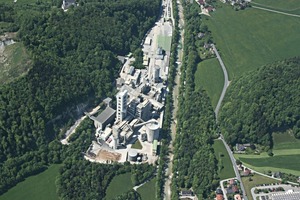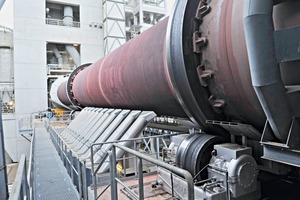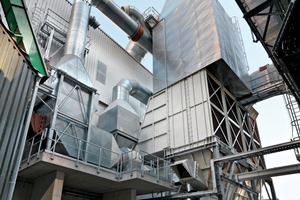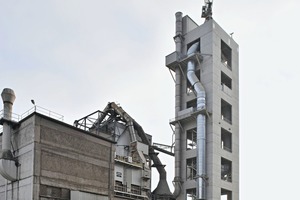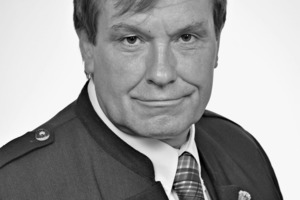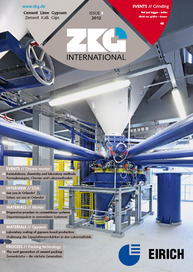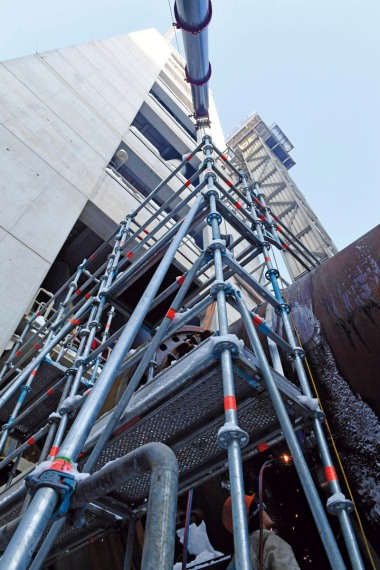The 20.10.2010 was a historical date for Zementwerk LEUBE GmbH: At exactly 8:10 p.m. was the start up for the new clinker production line. This € 31 million investment was the biggest made by LEUBE in the past 50 years. The new plant – widely visible by the landmark preheater tower with its height of over 100 m (Fig. 1) – is not only more cost-effective, but also provides a more environmental-friendly production. Compared to the old plant, the noise and exhaust gas emissions as well as the energy consumption were substantially reduced. ZKG asked Dr. Günter Waldl (Zementwerk LEUBE GmbH) and Dipl.-Ing. Wolfgang Freimann (A TEC) about operating experience with the new production line.
ZKG: Dr. Waldl, the plant was commissioned in October 2010. Please reflect on the final plant configuration.
Günter Waldl: The firststep towards the final plant configuration was the installation of a new raw meal dosing system. The concept included a 5-stage preheater with calciner and combustion chamber in a concrete tower with steel platforms. The project also necessitated shifting an existing rotary kiln (Fig. 2), installing a new kiln hood with clinker cooler and replacing the cooler exhaust air filter (Fig. 3). Also new were the fuel supply system (alternative fuels for the calciner), the clinker conveying equipment and the necessary exhaust gas and raw meal connections.
ZKG: What experience has been gained so far in the almost 1.5 years of operation? Were the set objectives achieved or where did you have to make plan corrections or adjustments?
Günter Waldl: We are able to flexibly control the kiln capacity over a wide range. Up to now we have been running daily capacity rates of between 1000 and 2000 t of clinker. This puts us in a position to react optimally to market conditions and seasonal fluctuations. The granted warranty figures for energy consumption and emissions were achieved. One outstanding point is the flexibility with regard to the fuel mix. And there have been absolutely no negative changes in clinker quality. All in all, the set objectives were achieved within a very short period of time and actually there were no plan corrections or major adjustments.
ZKG: Herr Freimann, what plant sections of Zementwerk Leube were equipped with special technological solutions and how have they proven themselves in operation?
Wolfgang Freimann: A TEC has gained a reputation as a specialist for the provision of special solutions for cement plants. In the Gartenau plant these solutions are:
A measurement system for the kiln inlet gas components carbon monoxide, nitrogen oxide and sulphur dioxide after the chlorine bypass filter. This system has achieved practically 100 % availability and provides a very precise indication of the quality of kiln operation.
The bypass cooling chamber (bypass quench), which is completely manufactured from special metals and has no refractory lining. It is therefore very light and has just a small footprint.
A TEC equipped the meal flap valves with so-called knife-edge bearings, which are characterized by great robustness and free movement.
The A TEC combustion chamber system with integral fuel feeding chute that swivels out in the case of an operational disturbance such as excessive pressure, while the feed pipe simultaneously closes to prevent the upstream mechanical conveying equipment from catching fire.
The A TEC calcination system is operated in substoichiometric mode in the combustion chamber and thus creates a relatively high concentration of reduced gas components. In the so-called mixing chamber, these meet the kiln exhaust gas with its content of nitrogen oxides and remove the oxygen from the nitrogen oxides for use in the oxidation process. Subsequently, the calciner exhaust gas is completely oxidized by mixing with tertiary air and a controlled amount of fresh air.
ZKG: Are these special solutions also usable in other plant concepts, and if so where and how?
Wolfgang Freimann: Gas measurement via the bypass filter naturally requires a gas bypass, but in such cases it is always recommendable and practicable. Due to the increasing use of alternative fuels, more and more kiln systems are being equipped with a bypass. Usually, the available space is limited and it is therefore necessary to pay special attention to the size of bypass cooling chamber and consequently the A TEC system is generally of advantage.
Sluggish meal flap valves can be replaced at any time with A TEC flap valves. The retrofitting of a combustion chamber is usually difficult because of its space requirement. Installation of a fuel feeding chute should be possible for most calciners. Split infeeding of calciner air should also be possible for most calciners, but usually only makes sense if the employed fuels have sufficiently volatile components, as is the case with most alternative fuels.
ZKG: Dr. Waldl, what advice would you give to a plant operator who is planning a similar project. What aspects require special attention, what has proven successful, what had to be changed?
Günter Waldl: Two aspects are particularly important: firstly, competent and totally committed plant staff (Fig. 4) to form a project team with clear ideas for the realization of the project and secondly an experienced partner to handle the engineering, plant construction and process technology.
ZKG: Were you able to keep to the project timetable, what could have been planned differently or should have been included in the plans?
Günter Waldl: Naturally, unplanned delays repeatedly occurred, especially during the construction work in the unpredictable Salzburg winter. However, considering the pressure we were under to assure a continuous supply of clinker to meet our plant‘s own needs and also the safety factors included in our planning, the commissioning of the new kiln system was virtually spot on.
ZKG: You decided in favour of a CemProTec cooler. What criteria were decisive for this decision and has the cooler proven itself in operation?
Günter Waldl: CemProTec was the best bidder. What finally convinced us was a visit to a reference plant in the UAE. For us, the decisive point was the design of the system with regard to optimum gas velocities. Our expectations have been met, as there is a clear atmosphere in our kiln and absolutely no dust deposits in the main horizontal tertiary air duct.
ZKG: What can you tell us about the cooler exhaust air filter. How does it help you to improve the total energy balance?
Günter Waldl: Right from the time of commissioning the filter has been operating without any disturbance. Due to the constant negative pressure at the kiln hood, the kiln operation is stable. With a view to improving the total energy balance, we are currently considering connecting our system to the local district heating network so that the heat which is not required or not utilizable for the technological processes in the cement plant can be used in a way that makes sense and is sustainable.
ZKG: Were any plant components installed or modernized upstream or downstream of the kiln line, and if so how?
Günter Waldl: During the 2011/2012 winter plant stoppage a new Scheuch bag filter with EMC technology was installed, as well as a new vertical mill separator with new cyclones and a new mill system fan. As a result, the modernized raw mill can grind the entire quantity of meal needed for the new kiln line and the dust emissions have been tremendously reduced.
ZKG: How did you solve the preparation of the fuel mixture and handling of the fuel?
Günter Waldl: Originally, we had planned only one transfer station for fuel supply to the calciner. However, in the course of the project and due to the positive cost development we decided to construct three stations and thus to improve the flexibility with regard to alternative fuel qualities and suppliers. That concept has proved its worth. Due to the fact that we have a very flexible logistics partner for supplying our alternative fuels, it has turned out that we do not require a large store for these materials at our plant, which is also very beneficial from a cost point of view. The calciner is for the most part operated without fossil fuels but the partial fluctuations in calorific value do not lead to any problems, as the plant configuration is optimally designed to cope with this.
ZKG: The project was successfully implemented on a clearly defined budget in a really short period of time and without any accidents. What are your aims for the future?
Günter Waldl: As LEUBE is a medium-sized, family-owned company, we are first looking for a good return on the substantial investments that we have made. We are therefore undertaking optimizations with regard to the alternative fuel usage rate and the energy consumption. Naturally we are also constantly carrying out emission-reduction measures. Thanks to the well-functioning overall concept of the new rotary kiln line, we are optimistic that we will achieve quick success with all these efforts.
ZKG: We wish you all the best and continued success with the new plant.

